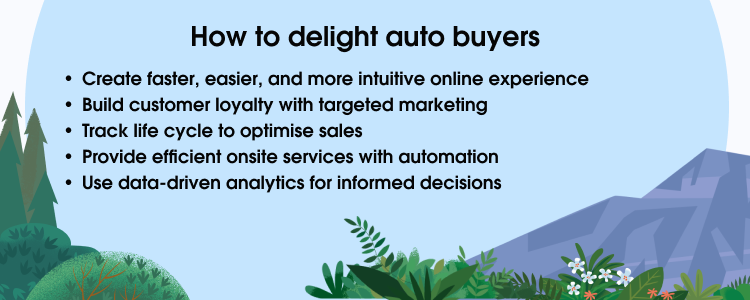Fuelling the Auto Buyer’s Experience with Intelligent Automation



Today’s auto buyers expect a seamless and personalised digital experience across sales and after-sales. Meet and even exceed their expectations with automation.

Gourav Ray
As the automotive sector grapples with rising input costs, inflation, competition, and supply chain woes, a larger challenge awaits them – the new-age auto customer. Today’s automotive buyer is far more discerning, demanding, impatient, and above all – tech-savvy. They don’t just want a high-quality vehicle (product), but also a high-quality experience (journey) across all touchpoints.
As automotive OEMs woo the new-age Gen Z customer, they’re looking to create a digital experience at every step of the auto buyer’s journey — from research to purchase to after-sales service. This is no longer a choice, it’s an expectation.
Minimising car-buying roadblocks through digitisation
Many customers are excited about buying a new vehicle — but few are excited about shopping for it. They value their time and don’t want to spend it driving from dealer to dealer. This is where mobile-enabled digital tools can allow them to do their research efficiently anytime, anywhere.
Today, the demand for shopping and comparing vehicles digitally is on the rise. This presents a huge opportunity for auto manufacturers. By combining various pieces of information – customer data, insights gathered through digital listening, demographic and psychographic data, and purchase and service history – OEMs can understand customer needs better, becoming proactive or even predictive with their outreach.
Armed with the right data and tools, they can move customers deeper into the research and consideration process, quickly narrowing their search, accelerating their buying decisions, and personalising their payment plans. Likewise, content and reviews can be leveraged to build the customer’s confidence in their purchase.
According to a Google survey, 18% of auto shoppers would purchase a vehicle sooner if there was an online option. Industry leaders are reading the writing on the wall. People are changing their buying habits, and online purchasing platforms are becoming just as important as brick and mortar. In short, the absence of easy-to-use online shopping tools will soon become a deal breaker for customers.
But even as things change, they stay the same.
Customers still want an immersive, personalised experience
As OEMs digitise the auto buyer’s journey, they still need to build an emotional and human connection. One way to do that is by leveraging immersive multimedia technologies in digital showrooms to simulate an in-person shopping experience — from video reviews to video tours, to augmented and virtual reality experiences.
Some dealers are investing in digital tools to walk customers through their purchases live. Others are using valet services for test drives, vehicle deliveries, and more.
One of the surest ways to make customers feel “seen” in this digital era is to personalise after-sales service. According to an Accenture survey, 71% of consumers reported they would increase their annual spending on aftersales if the experience improved. This represents a $210 million annual service revenue opportunity for OEMs.
Today, more OEMs are recognising the value of after-sales and service as a platform to win customers for life. They’re using customer data such as purchase history, service history, financing preferences, vehicle preferences, and more to craft reassuring omnichannel messages, including proactive service reminders and emergency financing offers.
One such company is Mercedes-Benz Silver Arrows, a franchise partner and dealer for Mercedes-Benz cars. Earlier, the company’s after-sales and ancillary products and services such as finance, insurance, accessories, body repair, and servicing were managed on disparate solutions. This meant that each vertical had a piecemeal view of customer needs. A customer too had to interact with multiple people for various requirements.
Today, however, all customer information across verticals throughout the customer lifecycle is consolidated on one platform – Salesforce – and managed through a key account manager (KAM) for each customer. The KAM has a single customer view across verticals to anticipate and fulfil requirements, while continually enhancing interactions. The customer, in turn, has a single point of contact for all their needs and enjoys a simplified and personalised experience.
Aligning OEMs and dealers for seamless customer engagement
As businesses and markets recover and grow, a collaboration between OEMs and dealers will become increasingly important in building customer satisfaction. Of course, that means aligning on-premise safety and sanitation measures. But it goes far beyond that too.
OEMs and dealers must work together to address what is currently a disconnected customer experience that’s caused when:
- Pricing and promotions are inconsistently communicated across hundreds of dealers
- OEM advertising and dealer advertising aren’t in synch
- Local dealer inventories aren’t meeting the promise of vehicles specified through OEM site configurators
These factors damage consumer confidence and slow down sales. This is why it’s so important to streamline customer engagement across an OEM and its dealers. With a shared platform, both parties can collaborate and share knowledge more efficiently. OEMs can also better identify qualified leads, and smoothly transfer them to dealers through dedicated dealer communication portals. Having a platform that functions as a dealer one-stop shop can help both OEMs and dealers reduce costs, and increase productivity.
Mahindra & Mahindra has experienced these benefits first-hand. The company united 18,000+ dealership users and 400+ call centre agents on a single platform, enabling them to deliver connected customer experiences. Dealers can now pick up a conversation with a lead right from where a service agent left off. They can also view customer data, handle inquiries, schedule test drives, gather feedback, and manage bookings – all on the go through their Salesforce mobile app.
Five steps to delight auto buyers
- Engineer online shopping to be faster, easier, and more intuitive.
- Build loyalty with intelligent marketing messaging that resonates with customer needs.
- Track automotive life cycles effectively — enabling timely, relevant “next car” sales communication.
- Deliver speedy onsite service with comprehensive customer data, knowledge articles, intelligent resource scheduling, and automated work order management.
- Use analytics and insights to power informed decision-making.

Engage customers like never before with Salesforce
Salesforce Automotive Cloud makes it easy to put customers at the centre of your business. All your teams and dealers can work together on one trusted platform to deliver exceptional experiences cost-efficiently. With Salesforce, you can strengthen car sales revenue through better lead conversion and collaboration, while also using industry-specific automation and intelligence for increased productivity and cost savings.
- Listen to customers and engage them at every touchpoint, including online, mobile devices, social media, showroom floors, and connected cars.
- Create personalised and seamless journeys before and after sales with a 360-degree customer view.
- Capture and route leads from any channel, and streamline the relationship from hand-raiser to test drive to sale.
- Empower field service agents with AI-based technology to improve customer service, drive efficiency, and increase first-time-fix rates.
This blog is adapted from the article that appeared here.























